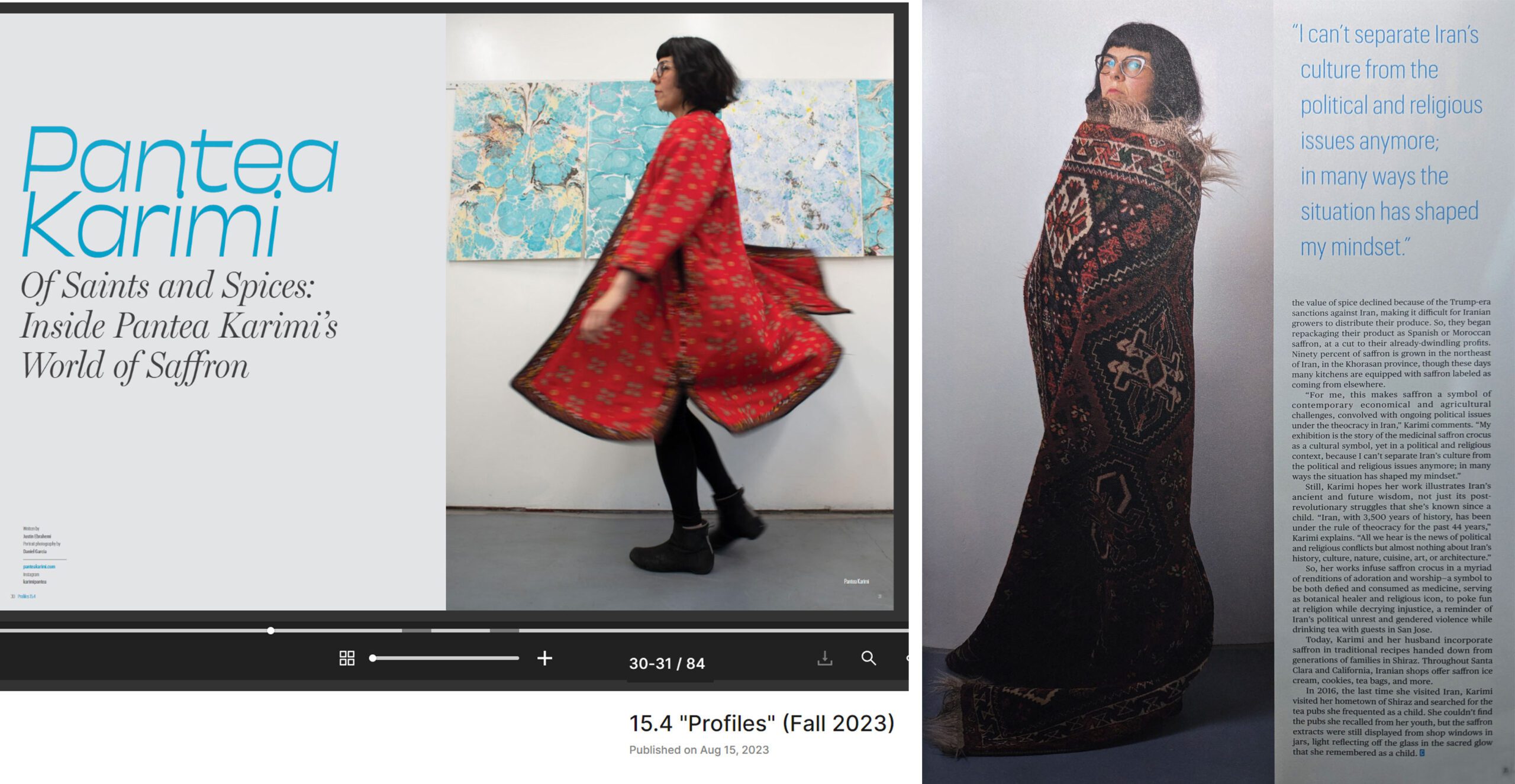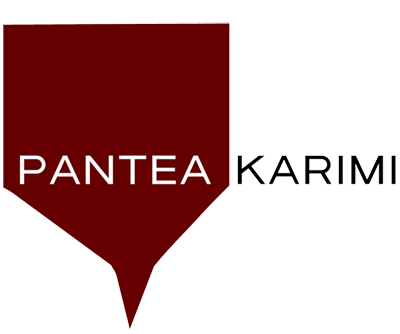by Justin Ebrahemi

‘Pantea Karimi’s childhood experiences in Iran inspired the artist’s holy multimedia exhibition on the saffron crocus and spice. ’
Pantea Karimi’s upbringing in Iran was colored by a world of scriptures and saints. A schoolchild of the first post-revolution generation, the artist’s education in the Islamic state was synonymous with religious indoctrination. This only made her obsess over religious motifs, as she took in the structures, deities, and art that painted her childhood. She grew up observing elaborate triptychs unfolding to parables of Islamic doctrine, studied the intricate geometry that decorates mosques, and marveled at the stained-glass windows ornating the building facades around her. To Karimi, the aesthetics of religion are fascinating.
Yet, a ubiquitous floral figure was brewing as a topic of interest from the San Jose-based Iranian American artist and scholar: saffron crocus, the archetype and deity of Karimi’s exhibition Saffron, Saint of Spices, recently on view at Triton Museum of Art in Santa Clara, California.
“In our religious courses, I was taught that saints did a lot of good, and performed miracles,” Karimi recalls. “Saffron crocus does both. It is a beautiful, medicinal flower whose use does miracles for the body and mind.”
Saffron is believed to balance moods and body temperature, reduce the effects of dementia, improve cognition, or fight cancer. Karimi’s grandmother taught Karimi about these natural healing benefits, along with her family who continue to integrate the flower in everyday facets of their life and cuisine. Whether for trade, cuisine or medicine, saffron has been a prominent tradition of her hometown of Shiraz since the medieval ages, and the love Karimi holds for the botanical realm stems from these herbal practices.
“As a child, the experience of cooking with plants felt magical and made me deeply connect to nature,” she says. “Its color and aroma that fills the kitchen and the house are the most familiar elements for me.”
After school, Karimi’s mother took her to an herbal extracts shop. Picture a traditional pub. Yet instead of the aroma of beer, the perfume of natural botanicals would emanate through the room. In lieu of bar stools, a long, metal bench continued along the wall and created a sense of community. And instead of alcohol, customers gathered to drink herbal extracts with ice and syrups. The popular extracts were contained in a row of large glass bottles along the floor, and when the sun shone through them, the pigmented glow was almost divine.
In Saffron, iconic Islamic symbolism is supplanted with multimedia interpretations of the crocus flower as a celebration (and at times a protest) of Iranian life. The exhibition is deliberately minimal in contrast to the busy ornamental stimuli of religious design.
“horror vacui means fear of empty space,” Karimi explains of her vision. “I was influenced by the concept because it represented beauty, and yet I resented it because it also represented the subjugation found in religious spaces. So I envisioned an anti-horror vacui religious space at the Triton.”
One holy interpretation, titled A Divine Allegory, includes a triptych containing archival images of saffron crocus that she replaced from Islamic religious text. Here Karimi used the late medieval and botanical Iranian printing technique of hand marbling which she then digitized for the triptych, an interactive object often used for religious storytelling.
Another work displays an illuminated 3D printed saffron crocus flower. Produced in collaboration with the UCSF Library Makers Lab team through multiple iterations, this crystalline sculpture is illuminated in a soft glow to necessitate worship. Elsewhere in the gallery, Sacred Threads i and ii displays a fountain representing Iranian shrines and Saqqaakhanaa, or religious water. Visitors in Islamic countries leave votive objects on the gridded exterior of the fountain as healing wishes. Here, red threads are tied to Karimi’s work symbolizing the 450 saffron threads that comprise one gram of spice.
Perhaps the most iconic work in Karimi’s show, Healing Chroma is a large, black oblique cube that resembles the Kaaba, the most holy Islamic site. The cube centers the gallery room atop a Persian rug (that Karimi has owned since childhood and brought back to San Jose 2011) and holds diluted saffron extracts in chromatic glass bottles. Light shines through the bottles by shadows casted by the cube, reminding Karimi of the extracts she marveled as a child in the Iranian tea pub.
Naturally, visitors of Saffron circle the cube as an unknown act of worship: In Mecca, Islamic pilgrims circumnavigate the Kaaba as an act of worship; at The Triton Museum, art visitors unknowingly mirror this ritual.
These hidden meanings behind the show are a wink from the artist, who holds a wealth of religious and botanical knowledge stemming from her upbringing in Iran and her education as an artist and scholar of geometry, math, and science. If the exhibition acts as a quiet subversion of religious indoctrination, its execution couldn’t be more timely.
In recent months the Women-Life-Freedom insurgence has uprooted daily Iranian life in countless deadly protests, as international media broadcasts the humanitarian crisis and social uprising. Though Iran’s media attention has largely faded, protests are ongoing and the death toll continues to climb. Rather than produce another protest work, Karimi decided to illustrate gendered violence through a more historical lens, that at once illustrates the immutable beauty and progression of Iranian culture while highlighting systemic injustice and the politics of nature.
In one of Saffron’s displays, multiple televisions present inaudible footage of the various stages of saffron production, from cultivation to harvest. Saffron is infamously known as a precious spice due to its difficulty to harvest the flower and cultivate for spice. To produce ten kilograms of saffron spice, 150,000 crocus flowers must be hand-picked. That’s 450,000 stigmas needed for ten kilograms. Moreover, it has to be harvested in late fall during the cold season, with challenging agriculture conditions exacerbated by climate change.
The work is arduous, and predominantly carried out by women.
“The fact that mainly women are involved during this difficult seasonal harvesting period was a huge factor and attention-grabbing for my work in this exhibition,” Karimi explains. “I read somewhere that the soft touch of a female hand makes for the best harvest.”
That may be part of the reason women serve as the majority of saffron agricultural laborers, despite being paid less than the men who package and distribute the spice. “The Women-Life-Freedom movement highlights the plight of female laborers, who must adhere to the strict dress codes during the intense harvesting season,” says Karimi. “Needless to say, the movement also highlights the rights of the female gender in Iran and makes me ponder about pay inequality.”
As flower, spice, and allegory, saffron extends from a religious and gendered motif to something innately political in Karimi’s show. In recent years the value of spice declined as a result of the Trump-era sanctions against Iran, making it difficult for Iranian growers to distribute their produce. So they began repackaging their product as Spanish or Moroccan saffron, at a cut to their already-dwindling profits. 90% of saffron is grown in the Northeast of Iran in the Khorasan province, though these days many kitchens are equipped with saffron disguised by another origin.
“For me, this makes saffron a symbol of contemporary economical and agricultural challenges, convolved with ongoing political issues under the theocracy in Iran,” Karimi comments. “My exhibition is the story of the medicinal saffron crocus as a cultural symbol, yet in a political and religious context, because I can’t separate Iran’s culture from the political and religious issues anymore; in many ways the situation has shaped my mindset.”
Still, Karimi hopes her work illustrates Iran’s ancient and future wisdom, not just its post-revolutionary struggles that she’s known since a child. “Iran with 3,500 years of history has been under the rule of theocracy for the past 44 years,” Karimi explains. “All we hear is the news of political and religious conflicts but almost nothing about Iran’s history, culture, nature, cuisine, art, or architecture.”
So her works infuses saffron crocus in myriad renditions of adoration and worship—a symbol to be both defied and consumed as medicine, serving as botanical healer and religious icon, to poke fun at religion while decrying injustice, a reminder of Iran’s political unrest and gendered violence while drinking tea with guests in San Jose.
Today, Karimi and her husband incorporate saffron in traditional recipes stemming down from generations of families in Shiraz. Throughout Santa Clara and California, Iranian shops offer saffron ice cream, cookies, tea bags and more.
In 2016, the last time she visited Iran, Karimi visited her hometown of Shiraz and searched for the tea pubs she frequented as a child. She couldn’t find the pubs she recalled from her youth, but the saffron extracts were still displayed from shop windows in jars, light reflecting off the glass in the sacred glow that she remembered as a child.
